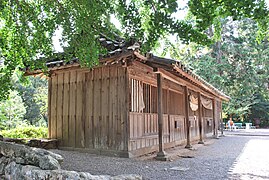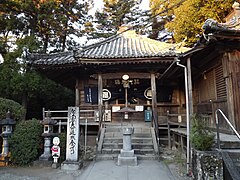Onzan-ji
The Onzan-ji ( Japanese 恩 山寺 ) with the Go Boyōzan ( 母 養 山 ) and Hōjuin ( 宝樹 院 ) in Komatsushima is a temple that belongs to the Shingon direction of Buddhism. In the traditional count, it is the 18th temple on the Shikoku pilgrimage route .
history
The temple is said to have been founded by priest Gyōki during the Tempyō era (729-749) at the request of the emperor Shōmu . He carved a statue of the healing Buddha himself, that is, of Yaskushi Nyorai as a seated person. At first the temple was called Dainichi san Fukushōin ( 大 日 山 福 生 院 ), to which women were not allowed. When priest Kūkai visited the temple during the Enryaku era (782–806) , his old mother, Tamayori Gozen ( 玉 依 御前 ), was therefore unable to accompany him. As a result, Kūkai prayed for seven days for the removal of this provision in order to enforce access. Since she was then taken in and well cared for, the temple was named Boyōsan Onzanji, which translates as "Temple that graciously cares for women". Kūkai made a self-portrait during the Kōnin era (810-824), which is a cult object in the hall of the temple founder, the Daishidō.
According to a document from 1203, the Onzanji temporarily came under the rule of the Koyasan . Later Minamoto no Yoritomo donated land to the temple. In the Muromachi period , the Hosokawa and Miyoshi promoted the temple. In the Edo period , it was the Hachisuka who restored eleven buildings and gave forests to the temple.
In 1898 most of the buildings were lost in a fire after a lightning strike. Among other things, the Daishidō was preserved.
investment
At the foot of the you already pass the simple temple gate ( 山門 , Sammon), which is adorned with oversized straw sandals. The actual temple area, surrounded by forest, begins higher up and can be reached from the street via a short flight of stairs. To the right is the Jizō Hall ( 地 蔵 堂 , Jizōdō; 5), which is dedicated to the holy Jizō , the protector of children. To the left is the hall in which the temple's founder is venerated, the Daishidō ( 大師 堂 ; 3), and across the corner next to it the small pavilion in which Kukai's mother's hair was cut ( 玉 依 御前 の 剃 髪 所 , Tamayori Gozen no teihatsujo; 4 ) and in which the mother's hair is kept. On the way ahead to the higher main hall ( 本 堂 , Hondō; 2) you pass the bell tower on the right ( 鐘楼 , Shōrō; 1).
There is a memorial stone on the temple grounds that indicates the visit to Minamoto no Yoritomo.
photos
Remarks
- ↑ There is a bronze statue of the archer Yoritomo in the nearby shrine.
- ↑ To the right of this is the small pavilion where Kūkai's mother's hair was cut.
literature
- Tokushima-ken no rekishi sampo henshu iinkai (Ed.): Onzan-ji . In: Tokushima-ken no rekishi sampo. Yamakawa Shuppan, 2009. ISBN 978-4-634-24636-2 . Page 203.
- Oguri, Doei: Kukai. Shikoku hachijuhachi kosho no arukikata. Chukei no Bunko, 2011. ISBN 978-4-8061-4067-2 .
Web links
Coordinates: 33 ° 59 ′ 9.6 " N , 134 ° 34 ′ 41.7" E








